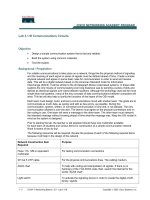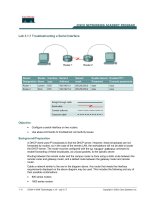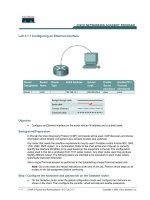Tài liệu Lab 3.1.5 Series Circuits docx
Bạn đang xem bản rút gọn của tài liệu. Xem và tải ngay bản đầy đủ của tài liệu tại đây (74.29 KB, 3 trang )
1 - 3 CCNA 1: Networking Basics v 3.0 - Lab 3.1.5 Copyright 2003, Cisco Systems, Inc.
Battery
Lab 3.1.5 Series Circuits
Switch
Bulb
Objective
• Build series circuits.
• Explore the basic properties of series circuits.
Background
One of the basic concepts in electronics is a circuit. A Circuit is a continuous loop through which
electrons flow. Throughout networking there are references to ground loop circuit, circuit versus
packet switching, and virtual circuits, in addition to all the real circuits formed by networking media
and networking devices. One of the fundamental electrical circuits is the series circuit. Most
networking devices and networks are built from very complex circuits that are beyond the scope of
the lessons included in this course. However, the process of building some series circuits will help
with the terminology and concepts of networking. This lab also helps increase the overall
understanding of some of the basic electrical circuit building blocks.
Prior to starting the lab, the teacher or lab assistant should have one multimeter available for each
team of students and various items to create circuits. Work in teams of two. The following resources
will be required:
• Fluke 110, 12B or equivalent multimeter
• Light switch
• Wire cutters or wire stripper
• Copper wire
• Two 6v light bulbs with bulb bases or LEDs with resistors
• 6v lantern battery
2 - 3 CCNA 1: Networking Basics v 3.0 - Lab 3.1.5 Copyright 2003, Cisco Systems, Inc.
Step 1 Measure the Resistances of all devices
Measure the resistances of all devices and components, except the lantern battery. All resistances
should be less than one Ohm (Ω), except the light bulbs. All the devices except the battery should
register continuity with the tone, indicating a short circuit or a conducting path.
Check the following resistances. Turn the meter off when finished or it will drain the battery.
Item to Measure the
Resistance of
Set Selector and
Range Scale to
Resistance Reading
Pieces of wire to connect
components
Light switch
Light bulbs
Step 2
Measure the voltage of the battery with nothing attached to it, unloaded.
Item to Measure the Voltage of Set Selector and Range
Scale to
Voltage Reading
6 V Lantern battery with no load
Step 3 Build a series circuit
Build a series circuit one device at a time. Use one battery, one switch, one bulb, and connecting
wires.
Connect the battery positive lead to the end of one wire. Connect the negative lead to the
other wire. If the switch is turned on, the bulb should light.
Disconnect one device and see that the circuit is broken. Did the bulb go out?
_______________________
Step 4 Measure the battery voltage
Measure the voltage across the light bulb while the circuit is running.
The switch should be turned on and the light bulb should be lit.
What was the voltage across the light bulb with the light bulb on?
_______________________
Step 5 Add the second bulb
Add a second bulb in series and measure the voltage across the light bulb again.
What was the voltage across the light bulb with the light bulb on?
_______________________
3 - 3 CCNA 1: Networking Basics v 3.0 - Lab 3.1.5 Copyright 2003, Cisco Systems, Inc.
Reflection
How do series circuits apply to networking?
__________________________________________________________________________
__________________________________________________________________________
__________________________________________________________________________









